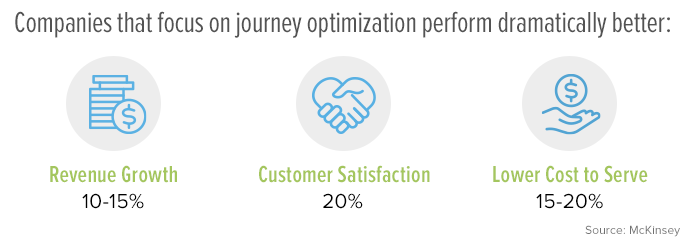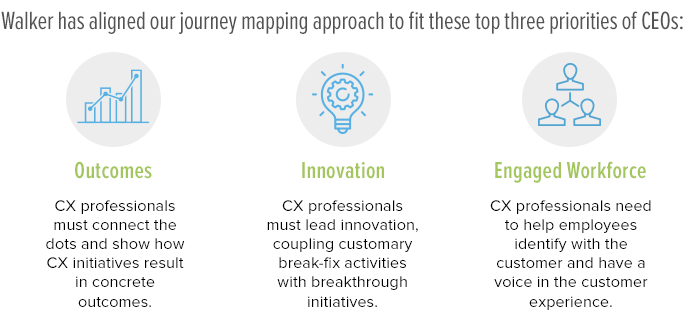Customer journey mapping is for companies that are interested in understanding the needs and expectations of their customers.
Journey mapping involves plotting the path customers take with your company – from first learning about your company through deciding to purchase, using your product or service, getting support and then deciding to purchase again. A good customer experience journey map is a powerful tool to support tactical and strategic design decisions.
Benefits of creating a journey map
Undertaking a journey mapping project is a great way to bring the customer experience to life for B2B companies. Companies often try to collect data solely through surveys, but employees become numb to the data reports. Journey mapping makes the customer story “pop” – employees and executives relate to the findings in a more meaningful way than survey data.
Three applications for journey mapping
B2B journey mapping can help companies in three main ways:
- Customer experience improvements. Journey mapping process can be used to identify breakdowns in customer experience so they can be fixed.
- Improving customer focus. Bringing the outside-in perspective of customers helps employees understand “a day in the life” of a customer. Because teams of employees come together and try to think like customers, it builds empathy for the customer that spills over into their daily interactions.
- Innovation. Using the current state journey map, a company can build upon it to picture the future ideal customer experience and plan how to reach that goal. This process encourages breakthroughs that can truly set your business apart from the competition.
Three principles for successful journey mapping
Keeping sound principles in mind can set your mapping project on the path to success. What should you keep in mind when setting out to map the customer journey?
- Have an objective. What are you trying to accomplish? Are you looking for customers to have a smoother experience? Are you trying to improve employees’ focus on customers? Are you trying to encourage breakthroughs that will create an ideal experience for your customers? Knowing your goal helps you plan how to reach it.
- Keep an outside-in perspective. Remember that you’re trying to create the story of what your customers experience when dealing with your company. Get the team to think like customers! Be careful that you don’t just create a process map – that’s not truly the journey as experienced by customers.
- Include customers in the process. Customers should be involved throughout the whole process. Ask them to say in their own words what their experience with your company is like, and use their responses to validate or disprove your team’s observations.
We at Walker have an unusual view: We believe the customer voice should be brought in at multiple points throughout the process. This helps make sure that what’s produced is truly an outside-in view of CX.
Ideal journey maps
AFFIRM ACTION PLANS, REVEAL OBSTACLES
Maps reveal where the risks and value are from the customer viewpoint. Our approach assures focus is on areas where the maximum impacts will occur.
GET THE RIGHT PEOPLE ENGAGED
Journey mapping creates opportunities for a large team to work together and creates new champions. Good maps are powerful tools that can be used to support tactical and strategic design decisions.
IMPROVE BUY-IN
By involving multiple stakeholders and soliciting feedback from key individuals, they are more likely to embrace the findings, which will lead to greater adoption and greater success of your program.
CREATE THE OPTIMAL LISTENING PROGRAM
By identifying what customers care about most, the map guides current customer metrics, and identifies gaps where surveys or other channels can focus.

Starting Point
Before you undertake journey mapping, you need to know where you’re coming from, what you hope to achieve and how the whole thing fits with your company’s goals.
Knowledgeable facilitators produce the best product. When Walker starts a journey mapping project with a company, we first perform foundational research. We examine your:
- Previous CX work
- Key leaders, including their customer strategies
- Business model
- Successes and struggles
- Objective: what you hope to accomplish by mapping the customer journey
Part of leading the journey mapping exercise is knowing how to ask the right questions. This foundational learning allows us to do so.
Building the journey mapping team
Journey mapping calls for teams of cross-functional groups of people who represent multiple points of contact for the customer from across the organization. Each person involved should possess the desire to truly understand the customer. These teams work collaboratively to look at the stages customers have with a company and identify which are the most important.
The journey mapping workshop should be led by someone who is experienced at facilitating workshops or training groups. He or she also needs a full understanding of the journey mapping process and, ideally, previous experience facilitating journey mapping workshops.
Customers, of course, need to weigh in throughout the process to ensure internal and external views are closely aligned.
Stages of the B2B customer journey
What are the typical stages of the B2B customer journey? The stages may vary, but an effective journey map makes it specific to the company. These are typical categories of stages:
- Awareness. The customer becomes aware of a company in a marketplace, usually through inbound or outbound marketing.
- Decision. The customer moves through researching different companies and choosing which one to use. This includes interacting with the website, salespeople and marketing materials.
- Onboarding/installation. The product or service is set up and the customer learns how to use it.
- Usage. The customer uses the product or service. This includes product installation or setup and customer service.
- Renewal. The customer chooses whether to buy again or to take their business elsewhere.
Each stage may have several touchpoints.
Moments of truth
A customer may have hundreds of interactions with a company. The ones that rise to the top are ‘moments of truth’ – the make-or-break touchpoints that a customer experiences. Identifying these is a key component of journey mapping.
Moments of truth are touchpoints that affect the customer’s likelihood to recommend the company or to buy from the company again. Some moments of truth are positive, like the person who begins to use new productivity software and wants to tell everyone how much more time he now has in his day. However, some moments of truth are pain points, such as the person who is trying to find out more about a company and can’t find what she wants to know on the website.
Often, the employees and customers have different ideas about which touchpoints will be most important. It’s important to identify which touchpoints have the biggest impact – and also how well the company is performing on them.
You should come out of the journey mapping workshop with a manageable number of moments of truth. These will probably shift or change once you get feedback from customers. The moments of truth become a guide. The positive moments are what you should promote in the marketplace – they are a competitive advantage for you. The negative moments of truth are pain points you should probably allocate resources to improve.
Journey mapping is qualitative research
Journey mapping draws out vivid stories of customer experiences. All the insights gathered – phone interviews with customers, face-to-face interviews with executives, collaborative exercises with cross-functional groups – are qualitative research, seeking to build ‘thick description.’
The insights gathered during journey mapping gives the CX team plenty of storytelling ammunition. You can add attention-grabbing quotes from customers to your presentations and distribute video clips of customers passionately describing working with your company.
Personas
Personas help companies understand customer qualities, such as:

WHO they are
WHAT they are trying to accomplish
WHAT goals drive their behaviors
HOW they think
HOW they feel
HOW they buy
WHY they make certain decisions

Just the Beginning
How do you follow through on journey mapping?
At Walker, we believe a journey map is not successful until it’s been activated in the culture.
Taking action
- Share the results. Make sure others in the company know what was found.
- Moments of truth – what the customers care about.
- Share perception gaps. Share what employees thought the customers wanted or needed and what the customer said they want.
- Plan improvements using the journey map.
- Plan ways to capitalize on positive moments of truth, as they are how your company shines.
- Plan ways to fix pain points so customers have a more positive experience with your company. Consider internal processes that are broken and points of customer interaction.
- Train teams based on what was found. For example, account managers need to know when working with customers which parts of the journey matter the most to customers.
- Use insights from journey mapping to drive the company’s strategy going forward.
Let Walker help you
- Walker supports you in activating the journey map by:
- Identifying 3-4 CX principles we think should be adopted by your company. These are kept simple, such as “Treat my time with respect” or “Don’t surprise me,” so that customer-facing employees can easily put them in practice.
- Working directly with executives to share results.
- Designing graphically appealing, easy-to-use journey maps.
- Designing and facilitating training and workshops.
Refreshing or replacing your journey map
Journey mapping is part of a comprehensive CX program. It lets you set goals based on things that really matter to customers and affect willingness to recommend and purchase again.
The journey map is only useful for as long as it reflects the current situation of the company. Consider doing a fresh journey map if your company has:
- Significant changes in how you work with customers
- Anything that will change the CX significantly
- A major leadership change
- A change in how products are delivered
Journey maps can also grow stale over time. They can be updated or refreshed on an annual or biannual schedule.
Walker’s journey mapping approach can help you create the right listening program, affirm action plans, reveal obstacles and get the right people engaged to help you make customer experience your biggest competitive advantage.
Start a conversation with Walker Contact Us